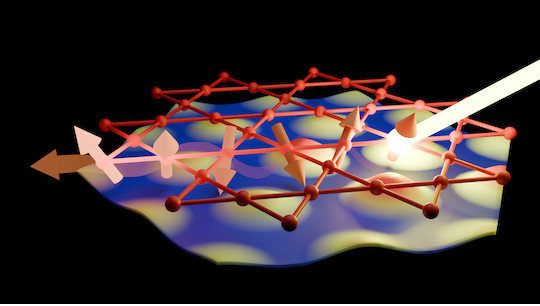Rice University researchers and collaborators uncovered direct evidence of active flat electronic bands in a kagome superconductor. This innovation may pave the way for new techniques of designing quantum materials, such as superconductors, topological insulators, and spin-based electronics, which might power future electronics and computing technologies. The study was published in Nature Communications on August 14th, 2025.

Image Credit: Zehao Wang
The study focuses on the chromium-based kagome metal, CsCr3Sb5, which turns superconducting under pressure.
Kagome metals, known for their two-dimensional lattices made up of corner-sharing triangles, have been predicted to host compact molecular orbitals. These orbitals, essentially standing-wave patterns of electrons, could give rise to unique magnetic orders driven by electron correlation effects, as well as support unconventional forms of superconductivity.
These flat bands play an active role in CsCr3Sb5 and have a direct impact on the material’s properties. In most other materials, however, the flat bands sit too far from the relevant energy levels to significantly influence their behavior.
The study was headed by Di-Jing Huang of Taiwan's National Synchrotron Radiation Research Center and Pengcheng Dai, Ming Yi, and Qimiao Si of Rice’s Department of Physics and Astronomy and Smalley-Curl Institute.
Our results confirm a surprising theoretical prediction and establish a pathway for engineering exotic superconductivity through chemical and structural control.
Pengcheng Dai, Sam and Helen Worden Professor, Physics and Astronomy, Rice University
The discovery offers experimental evidence for concepts previously only found in theoretical models. It also demonstrates how the complex shape of kagome lattices can be employed as a design tool to regulate the behavior of electrons in solids.
By identifying active flat bands, we have demonstrated a direct connection between lattice geometry and emergent quantum states.
Ming Yi, Associate Professor, Physics and Astronomy, Rice University
The study team investigated the presence of active standing-wave electron modes using theoretical modeling along with two advanced synchrotron techniques.
By mapping electrons released under synchrotron light using angle-resolved photoemission spectroscopy (ARPES), they were able to identify unique characteristics linked to compact molecular orbitals. Magnetic excitations associated with these electronic modes were observed by resonant inelastic X-Ray scattering (RIXS).
The ARPES and RIXS results of our collaborative team give a consistent picture that flat bands here are not passive spectators but active participants in shaping the magnetic and electronic landscape. This is amazing to see given that, until now, we were only able to see such features in abstract theoretical models.
Qimiao Si, Harry C. and Olga K. Wiess Professor, Physics and Astronomy, Rice University
The impact of strong electron correlations was explored through theoretical analysis, starting with a custom-designed electronic lattice model that replicated the observed properties and provided a framework for interpreting the results. This portion of the study was led by co-first author and Rice Academy Junior Fellow Fang Xie .
According to Zehao Wang, a graduate student at Rice and co-first author, obtaining such precise data required producing exceptionally large and pure crystals of CsCr3Sb5. This was achieved through a refined technique that generated samples about 100 times larger than those previously available.
According to Yucheng Guo, a Rice graduate student and co-first author who oversaw the ARPES effort, the study highlights the potential of collaborative research across academic disciplines.
“This work was possible due to the collaboration that consisted of materials design, synthesis, electron and magnetic spectroscopy characterization, and theory,” Guo explained.
Yuefei Huang, Bin Gao, Ji Seop Oh, Han Wu, Zheng Ren, Yuan Fang, Yiming Wang, Ananya Biswas, Yichen Zhang, Ziqin Yue, Boris Yakobson and Junichiro Kono are the co-authors from Rice.
Hsiao-Yu Huang, Jun Okamoto, Ganesha Channagowdra, Atsushi Fujimori and Chien-Te Chen of Taiwan’s National Synchrotron Radiation Research Center; Xingye Lu of Beijing Normal University; Zhaoyu Liu and Jiun-Haw Chu of the University of Washington; Cheng Hu, Chris Jozwiak, Aaron Bostwick and Eli Rotenberg of the Lawrence Berkeley National Laboratory; Makoto Hashimoto and Donghui Lu of the SLAC National Accelerator Laboratory; Robert Birgeneau of the University of California, Berkeley; and Guang-Han Cao of Zhejiang University are the other study contributors.
The US Department of Energy, Robert A. Welch Foundation, Gordon and Betty Moore Foundation, Air Force Office of Scientific Research, National Science Foundation, and Vannevar Bush Faculty Fellowship program provided support for this study.
Journal Reference:
Wang, Z., et al. (2025) Spin excitations and flat electronic bands in a Cr-based kagome superconductor. Nature Communications. doi.org/10.1038/s41467-025-62298-5.